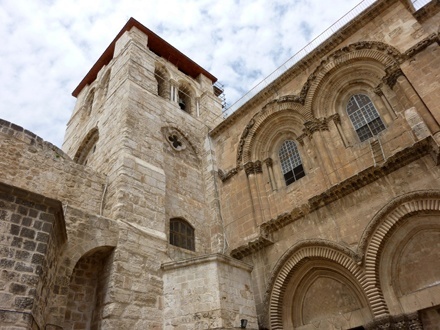
Earthquakes, holy sites and Haiti
Monday, May 17, 2010
*Tom Tracy
Sometimes journalists embark on a reporting trip or assignment knowing more or less what we plan to write about; then we go looking for those stories and anecdotes. It’s a starting point, and we all need to start somewhere.
A recent trip to the holy lands of Israel, Greece and Turkey was not, however, one of those occasions. From the moment our pilgrimage group of 45 Florida Catholics hit the ground in the ancient port city of Caesarea, in modern-day Israel, until our last stop at the ruins of Knossos, Greece, we heard the word “earthquake” consistently.
Since January 12, that word sounds terrible and raw to our ears in south Florida.
Earthquakes, we were reminded by our various tour guides, have been a frequent phenomenon in the Mediterranean and Bible land regions. They have been a serious source of destruction and historical game-changers for entire civilizations.
As we watched a film at the Caesarea National Park site, we learned how an earthquake brought ruin to that most important port-harbor built by King Herod. Later, a visual shows how a beautiful, octagonal-shaped church once stood there upon the remains of a Roman temple.

Photographer: TOM TRACY
The cathedral in Port-au-Prince was severely damaged in the Jan. 12, 2010 earthquake.
Worse yet, earthquakes in ancient times sometimes meant total abandonment of cities or the end of local civilizations. Sometimes cities are vacated for several centuries before they are repopulated; other times they vanish forever.
The striking archeological site at Ephesus, Turkey, where St. Paul set foot, may have been the most visually moving of our archeological field trips. The ancient city there was highly developed with an impressive library and what must have been gorgeous civic spaces. Before Paul arrived, an earthquake had severely damaged Ephesus, but it was later partly rebuilt. Several centuries on, anther earthquake brought further heavy damage to this cultural gem, which served as the site of the Fourth Ecumenical Council where the Church declared Mary the “Mother of God.”
On the island of Crete, which Paul visited in the year 59, we walked through the ruins of the Knossos Palace, which was the ceremonial and political center of the Minoan civilization and culture. It has known human settlements at least since 7,000 B.C. The palace there was twice severely damaged, first by fire and later by a major earthquake, causing temporary abandonment of the site and later resettlement.
The ancient biblical sites of Mediggo, Jericho and Qumran, all on our itinerary, have known periods of natural destruction during their histories — archeologists think probably due to earthquakes.

Photographer: TOM TRACY
The Church of the Holy Sepulchre in Jerusalem also has been damaged by earthquakes over the centuries.
I must have been day-dreaming as our tour guide, Nader, a Syrian-Orthodox native of Jerusalem who grew up in Catholic schools there, explained why the monument is being held together by supporting steel beams and scaffolding. I asked again for an explanation and he repeated: the ravages of time – modern-day earthquakes in particular – have compromised the integrity of the tomb.
Reading an online history of the Holy Sepulcher back home, I saw that in the early 1800s, earthquakes and fires damaged the church. The repairs began “with great delay in 1867-1869” and the big dome of the temple was renovated in part with support coming from the churches in Russia, France and Turkey: that was a 30-year repair delay to be exact. The big 1927 earthquake near Jericho further damaged the Holy Sepulcher and other religious sites in Jerusalem’s Old City.
In the case of Haiti, one wonders in reality how the cathedral and church rebuilding efforts will proceed, in terms of timing and resources, international cooperation, as well as style and engineering of the rebuilding. Will some sections of the cathedral be salvageable or will it need to be leveled to make room for a new temple? Will the new cathedral be more modern, or classic? How many years will have passed before Mass is again celebrated in the cathedral of Port-au-Prince?
There are certainly more pressing, human matters to be addressed right now in Haiti, and history cautions that we cannot be altogether sure if Port-au-Prince will ultimately remain Haiti’s center of political, civic and religious life — although it appears likely for now.
The history of the Holy Lands reminds us that temples rise and fall and are rebuilt again, in original or sometimes new locations. Influences and centers of power shift. The temples and religious edifices — both destroyed and rebuilt — also stand as important symbols for future generations.


Comments from readers